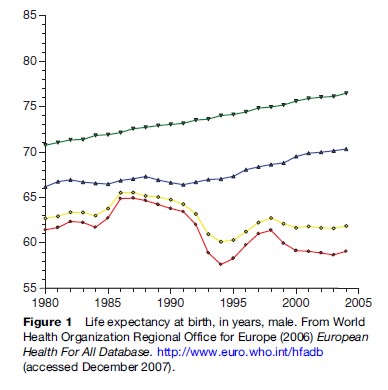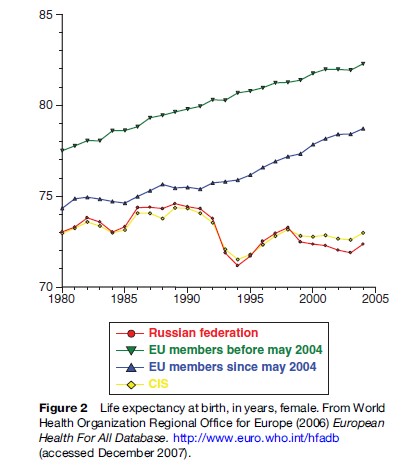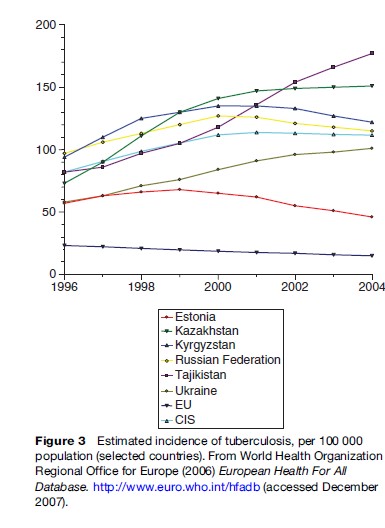The human cost of transition has been enormous. The region has experienced dramatic changes in its demographic and health indicators, which compare unfavorably with the indicators in Western Europe and the countries in central Europe. In the post-war period, the Soviet system made considerable progress in establishing universal health and education systems, implementing universal immunization programs and eradicating cholera, malaria, and typhoid based on scaling up basic interventions. As a result, until the late 1960s, many former Soviet republics achieved increasingly good health outcomes given their level of economic development. However, the health-care and health promotion systems were less effective in undertaking more complex programs required to respond to the changing disease patterns and risk factors associated with aging, urbanization and industrialization (smoking, alcoholism), and noncommunicable diseases. As a result, since the 1960s, life expectancy in most countries of the FSU did not improve in line with the rises achieved in the West (McKee, 2001). This epidemiological departure was driven largely by rising death rates from heart disease, injuries, and violence. The persistence of the previous system’s deficiencies were exacerbated by complex transition processes and resulted in worsening mortality and morbidity outcomes. By 2004, life expectancy at birth was almost 11 years less in the countries of the FSU than in Western Europe, a gap that is still widening (Figures 1 and 2). The region is one of only two in the world where life expectancy is currently declining, with the other being sub-Saharan Africa (McMichael et al., 2004). Russia in particular has faced a major crisis in mortality in middle-aged men. The reasons for this health crisis can be attributed to lifestyle factors (binge drinking, high levels of smoking, lack of exercise, and poor nutrition). An alternative explanation is simply that these are expressions and mediators in the causal pathway, of profound psychosocial ill health (McKee, 2001). While many of the reasons for this deterioration lie outside the health-care sector, the need for effective health care that can respond to these challenges and promote health has never been greater.
 The example of infant and maternal mortality illustrates how persisting poor outcomes relate to structural fault lines in the health-care system. While countries of the Soviet Union had achieved significant progress in reproductive health outcomes in the post-war period, by the 1980s, infant and maternal mortality was lagging well behind Western European levels (WHO, 2006). Despite universal access to an extensive network of maternity facilities, maternal care outcomes in Russia have failed to improve despite excess capacity, large numbers of specialists, and prolonged preventive hospitalizations in normal pregnancy (Danishevski et al., 2006b). There are extremely wide variations in clinical practice (e.g., in the rates for cesarean section and episiotomy). Some correlate with socioeconomic characteristics of mothers (rather than clinically determined need), but others correlate with equipment availability or health system structures and processes. Moreover, a culture of over medicalization combined with a lack of pragmatic and evidence-based care has resulted in an interventionist clinical practice that is both ineffective and inefficient. Although professional clinical autonomy has been fiercely protected despite centrally developed guidelines (meaning that outmoded care models often persist), methods for payment to providers have frequently resulted in distortions in care processes that maximize provider income rather than improve clinical outcomes. For example, maternal care interventions are often performed to obtain informal payments and users are hospitalized in order to sustain institutional bed capacity.
The example of infant and maternal mortality illustrates how persisting poor outcomes relate to structural fault lines in the health-care system. While countries of the Soviet Union had achieved significant progress in reproductive health outcomes in the post-war period, by the 1980s, infant and maternal mortality was lagging well behind Western European levels (WHO, 2006). Despite universal access to an extensive network of maternity facilities, maternal care outcomes in Russia have failed to improve despite excess capacity, large numbers of specialists, and prolonged preventive hospitalizations in normal pregnancy (Danishevski et al., 2006b). There are extremely wide variations in clinical practice (e.g., in the rates for cesarean section and episiotomy). Some correlate with socioeconomic characteristics of mothers (rather than clinically determined need), but others correlate with equipment availability or health system structures and processes. Moreover, a culture of over medicalization combined with a lack of pragmatic and evidence-based care has resulted in an interventionist clinical practice that is both ineffective and inefficient. Although professional clinical autonomy has been fiercely protected despite centrally developed guidelines (meaning that outmoded care models often persist), methods for payment to providers have frequently resulted in distortions in care processes that maximize provider income rather than improve clinical outcomes. For example, maternal care interventions are often performed to obtain informal payments and users are hospitalized in order to sustain institutional bed capacity.
 In parallel to excessive mortality and morbidity from chronic diseases, some communicable diseases are emerging as important public health threats, such as HIV/AIDS and tuberculosis (including multidrug-resistant tuberculosis) (Figures 3 and 4).
In parallel to excessive mortality and morbidity from chronic diseases, some communicable diseases are emerging as important public health threats, such as HIV/AIDS and tuberculosis (including multidrug-resistant tuberculosis) (Figures 3 and 4).

